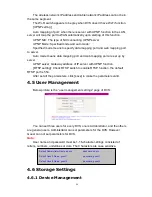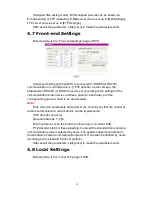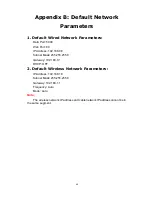
30
After revise and save parameters, the device will restart. If it is applied in
LAN, please pay attention to avoid conflict between its IP address and the IP
addresses of other devices or PC in the LAN.
[Active connection mode]
Active connection switch: Enable or disable active connection of the device
to surveillance center.
Central server address: The address of surveillance center (e.g.
192.168.55.8).
Central server port: The port of surveillance center (e.g. 6000).
[Wireless network transmission mode]
Enable or disable wireless network transmission mode which applies to
devices that are connected to wireless network of carriers.
[DDNS setting]
Bind the device with a fixed domain name by DNNS setting so that visit to
the device can be realized no matter how the public IP changes (refer to
Appendix C for detailed steps)
DDNS On/Off: Enable or disable DDNS function.
DDNS User Name: User registered in DDNS server.
DDNS Password: User password registered in DDNS server.
DDNS Domain Name: The Domain Name set for long-distance access after
user log in.
DDNS Address: DDNS server address. When DDNS address is the domain
Name, please set the DNS address in [Basic Parameters] correctly.
DDNS Port: Default port is 30000.
Data Mapping Port: When DVS is mapped to public network via router, fill in
the public data port number after mapping.
Web Mapping Port: When DVS is mapped to public network via router, fill in
the public web port number after mapping.
[PPPOE setting]
PPPOE switch: Enable or disable PPPOE dial-up function.
PPPOE address: After successful setting of device dial-up, it will display the
public IP Address.
PPPOE user name: ADSL dial-up account, obtain from the IP service
provider.
PPPOE password: ADSL dial-up password, obtain from the IP service
provider.
On-line duration: Start timing after dial-up to see the online duration after
successful dial-up.
After set all the parameters, click [save] to make the parameters valid.
2.
Advanced Settings
Below picture is the “advanced network settings” page of DVS:
















































